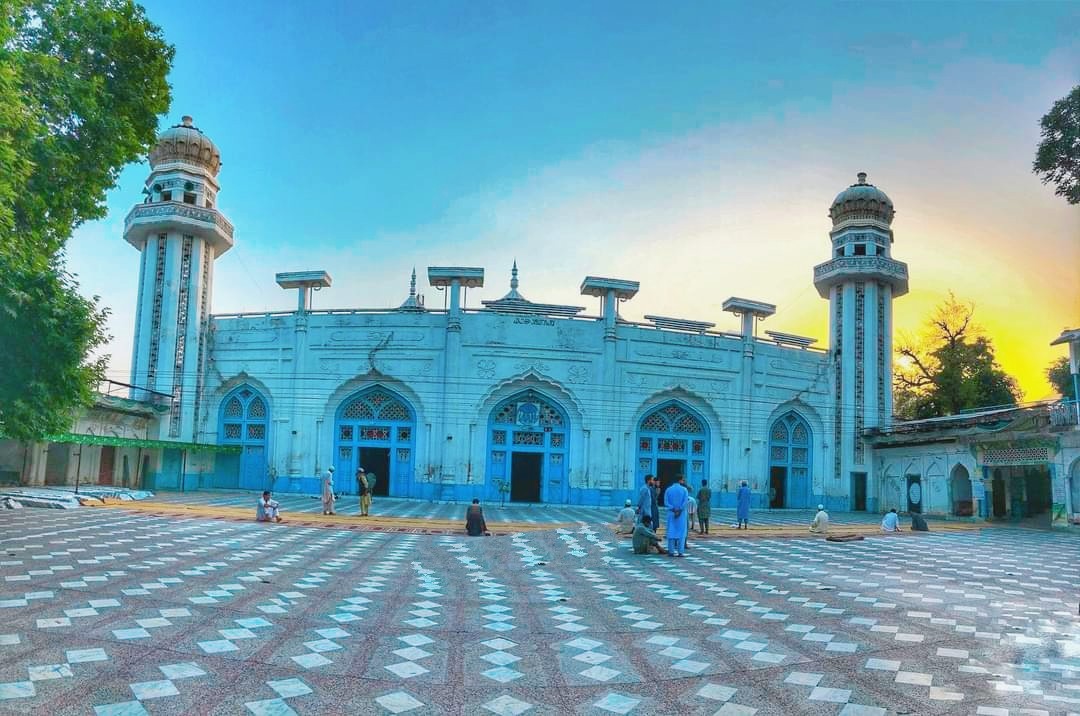|
Elum Ghar
Elum Ghar, also known as Mount Ilam is a mountain located between the Swat and Buner districts of Pakistan. Elum Ghar is the highest peak in the region, and is snow-covered most of the year. It is located west of Pir Baba's shrine in the Buner District of the Khyber Pakhtunkhwa of Pakistan. The mountain was a significant pilgrimage site for Hindus until 1947, and is believed to be the site where a previous incarnation of the Buddha gave up his life. The city of Mingora can be seen from atop the mountain. The mountain is popular among hikers due to its many streams and lakes that can be seen while going up the mountain. Going up is tough as there is no local transport. History Archaeologists have found ruins of the Indus Valley civilization around the mountain, and believe that there may still be more buried ancient ruins. The top of the mountain is locally known as "Jogiano sar". This site is also significant in Hinduism. The mountain has snakes and cobras near the top. T ... [...More Info...] [...Related Items...] OR: [Wikipedia] [Google] [Baidu] |
Pir Baba
Sayyid Ali Tirmizi ( ps, سيد علي ترمذي), more commonly known as Pir Baba (), was a Naqvi Sayyid, and a Sufi who settled in Buner (present-day Khyber Pakhtunkhwa, Pakistan) among the Yusufzai Pashtuns. He was probably born in 908 AH (1502 CE), in Fergana (present-day Uzbekistan), of Sayyid descent, died in AH 991 (1583 CE). He was a supporter of the Mughal emperor Babar, and was an opponent of Bayazid Pir Roshan. It is claimed that Pir Baba was the son of Sayyid Qamar Ali, who was in emperor Babur's army and had come down to Delhi as the governor of the Indian state. His mother was of Uzbek origin. Baba was more inclined towards Islamic studies. Baba supposedly married a sister of Daulat Khan a Yusufzai; a respected Pashtun from Buner. He had 2 sons, Sayyid Habibullāh Shaah and Sayyid Mustafa Shaah. Anwar Baig Baghi, a descendant of Pir Baba in his 12th generation, made news because "he could read only up to fifth grade but he penned down over 50 books on a variety ... [...More Info...] [...Related Items...] OR: [Wikipedia] [Google] [Baidu] |
Buner District
Buner District ( ps, بونیر ولسوالۍ, ur, ) is a district in Malakand Division of Khyber Pakhtunkhwa province in Pakistan. Before becoming a district in 1991, it was a tehsil within Swat District. History The Buner Valley lies between Swabi on the South and Swat on the North. It is a mountain valley, dotted with villages and divided into four sub-divisions. The Mora Hills and the Ilam range divide it from the Swat Valley, the Sinawar range from Yusafzai, the Guru mountains from the Mardan Valley, and the Duma range from the Puran Valley. During the 1580s, many Yusufzais and Mandanrs rebelled against the Mughal Empire. In late 1585, Mughal Emperor Akbar sent military forces under Zain Khan Koka and Birbal to crush the rebellion. In February 1586, about 8,000 Mughal soldiers, including Birbal, were killed near the Karakar Pass by the Yusufzai lashkar, led by Kalu Khan. This was the greatest disaster faced by the Mughal Army during Akbar's reign. During the 19t ... [...More Info...] [...Related Items...] OR: [Wikipedia] [Google] [Baidu] |
Khyber Pakhtunkhwa
Khyber Pakhtunkhwa (; ps, خېبر پښتونخوا; Urdu, Hindko: خیبر پختونخوا) commonly abbreviated as KP or KPK, is one of the Administrative units of Pakistan, four provinces of Pakistan. Located in the Geography of Pakistan, northwestern region of the country, Khyber Pakhtunkhwa is the smallest province of Pakistan by land area and the Demographics of Pakistan, third-largest province by population after Punjab, Pakistan, Punjab and Sindh. It shares land borders with the Pakistani provinces of Balochistan, Pakistan, Balochistan to the south, Punjab, Pakistan, Punjab to the south-east and province of Gilgit-Baltistan to the north and north-east, as well as Islamabad Capital Territory to the east, Azad Jammu and Kashmir, Autonomous Territory of Azad Jammu and Kashmir to the north-east. It shares an Durand Line, international border with Afghanistan to the west. Khyber Pakhtunkhwa is known as a tourist hot spot for adventurers and explorers and has a varied landsca ... [...More Info...] [...Related Items...] OR: [Wikipedia] [Google] [Baidu] |
Pakistan
Pakistan ( ur, ), officially the Islamic Republic of Pakistan ( ur, , label=none), is a country in South Asia. It is the world's List of countries and dependencies by population, fifth-most populous country, with a population of almost 243 million people, and has the world's Islam by country#Countries, second-largest Muslim population just behind Indonesia. Pakistan is the List of countries and dependencies by area, 33rd-largest country in the world by area and 2nd largest in South Asia, spanning . It has a coastline along the Arabian Sea and Gulf of Oman in the south, and is bordered by India to India–Pakistan border, the east, Afghanistan to Durand Line, the west, Iran to Iran–Pakistan border, the southwest, and China to China–Pakistan border, the northeast. It is separated narrowly from Tajikistan by Afghanistan's Wakhan Corridor in the north, and also shares a maritime border with Oman. Islamabad is the nation's capital, while Karachi is its largest city and fina ... [...More Info...] [...Related Items...] OR: [Wikipedia] [Google] [Baidu] |
Buddha
Siddhartha Gautama, most commonly referred to as the Buddha, was a śramaṇa, wandering ascetic and religious teacher who lived in South Asia during the 6th or 5th century BCE and founded Buddhism. According to Buddhist tradition, he was born in Lumbini, in what is now Nepal, to royal parents of the Shakya clan, but Great Renunciation, renounced his Householder (Buddhism), home life to live as a wandering ascetic ( sa, śramaṇa). After leading a life of begging, asceticism, and meditation, he attained Enlightenment in Buddhism, enlightenment at Bodh Gaya in what is now India. The Buddha thereafter wandered through the lower Indo-Gangetic Plain, teaching and building a Sangha, monastic order. He taught a Middle Way between sensual indulgence and severe asceticism, leading to Nirvana (Buddhism), Nirvana, that is, Vimutti, freedom from Avidyā (Buddhism), ignorance, Upādāna, craving, Saṃsāra (Buddhism), rebirth, and suffering. His teachings are summarized in the Noble ... [...More Info...] [...Related Items...] OR: [Wikipedia] [Google] [Baidu] |
Mingora
Mingora ( ps, مینګورہ, ur, ) is a city in the Swat District of Khyber Pakhtunkhwa, Pakistan. Located on the Swat River, it is the 3rd largest city in Khyber Pakhtunkhwa and the 26th largest in Pakistan. Mingora is the largest city and the epicenter of social, cultural, and economic activities in Malakand Division, and also the largest in the northern part of Khyber Pakhtunkhwa. History The area around Mingora has long been inhabited. At Loe Banr, Butkara II and Matalai, Italian archaeologists unearthed 475 Indo-Aryan graves dated between 1520 and 170 BC and two horse skeletons. On the opposite side of the River Swat at Aligrama, near the Saidu Sharif airport, a site of Gandhara grave culture was discovered by Italian archaeologists and dated to 1000 BC. Buddhism arose in the region with the arrival of monks from the Gangetic plains. Under Emperor Ashoka, Buddhism became firmly established in the region, and the region became a launching ground for Ashoka's expansion ... [...More Info...] [...Related Items...] OR: [Wikipedia] [Google] [Baidu] |
Indus Valley Civilization
The Indus Valley Civilisation (IVC), also known as the Indus Civilisation was a Bronze Age civilisation in the northwestern regions of South Asia, lasting from 3300 BCE to 1300 BCE, and in its mature form 2600 BCE to 1900 BCE. Together with ancient Egypt and Mesopotamia, it was one of three early civilisations of the Near East and South Asia, and of the three, the most widespread. Its sites spanned an area from much of Pakistan, to northeast Afghanistan, and northwestern India. The civilisation flourished both in the alluvial plain of the Indus River, which flows through the length of Pakistan, and along a system of perennial monsoon-fed rivers that once coursed in the vicinity of the Ghaggar-Hakra, a seasonal river in northwest India and eastern Pakistan. The term ''Harappan'' is sometimes applied to the Indus civilisation after its type site Harappa, the first to be excavated early in the 20th century in what was then the Punjab province o ... [...More Info...] [...Related Items...] OR: [Wikipedia] [Google] [Baidu] |
Giuseppe Tucci
Giuseppe Tucci (; 5 June 1894 – 5 April 1984) was an Italian orientalist, Indologist and scholar of East Asian studies, specializing in Tibetan culture and the history of Buddhism. During its zenith, Tucci was a supporter of Italian fascism, and he used idealized portrayals of Asian traditions to support Italian ideological campaigns. Tucci was fluent in several European languages, Sanskrit, Bengali, Pali, Prakrit, Chinese and Tibetan and he taught at the University of Rome La Sapienza until his death. He is considered one of the founders of the field of Buddhist Studies. Life and work Education and background He was born to a middle-class Italian family (from Apulia) in Macerata, Marche, and thrived academically. He taught himself Hebrew, Chinese and Sanskrit before even going to university and in 1911, aged only 18, he published a collection of Latin inscriptions in the prestigious '' Zeitschrift des Deutschen Archäologischen Instituts''. He completed his studies at the ... [...More Info...] [...Related Items...] OR: [Wikipedia] [Google] [Baidu] |
Aornos
Aornos ( grc, Ἄορνος) was site of Alexander the Great's last siege, which took place on April 326 BC, at a mountain site located in modern Pakistan. Aornos offered the last threat to Alexander's supply line, which stretched, dangerously vulnerable, over the Hindu Kush back to Balkh, though Arrian (although disbelieving himself of this story) credits Alexander's desire to outdo his kinsman Heracles, who allegedly had proved unable to take a fort that the Macedonians called Ἄορνος ''Aornos'' (according to Arrian and Diodorus; ''Aornis'' according to Curtius; elsewhere ''Aornus''): meaning "birdless" in Greek. According to one theory, the name is a corruption of an Indo-Iranian word, such as *awarana "fortified place". According to Arrian, the rock had a flat summit well-supplied with natural springs and wide enough to grow crops: it could not be starved into submission. Neighboring tribesmen who surrendered to Alexander offered to lead him to the best point of acc ... [...More Info...] [...Related Items...] OR: [Wikipedia] [Google] [Baidu] |
Alexander The Great
Alexander III of Macedon ( grc, wikt:Ἀλέξανδρος, Ἀλέξανδρος, Alexandros; 20/21 July 356 BC – 10/11 June 323 BC), commonly known as Alexander the Great, was a king of the Ancient Greece, ancient Greek kingdom of Macedonia (ancient kingdom), Macedon. He succeeded his father Philip II of Macedon, Philip II to the throne in 336 BC at the age of 20, and spent most of his ruling years conducting a lengthy military campaign throughout Western Asia and ancient Egypt, Egypt. By the age of thirty, he had created one of the List of largest empires, largest empires in history, stretching from Greece to northwestern Historical India, India. He was undefeated in battle and is widely considered to be one of history's greatest and most successful military commanders. Until the age of 16, Alexander was tutored by Aristotle. In 335 BC, shortly after his assumption of kingship over Macedon, he Alexander's Balkan campaign, campaigned in the Balkans and reasserted control ... [...More Info...] [...Related Items...] OR: [Wikipedia] [Google] [Baidu] |

.jpg)

